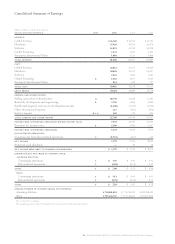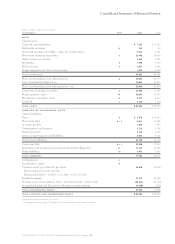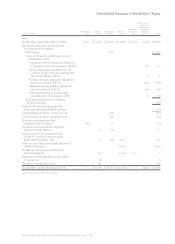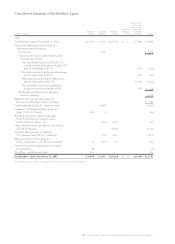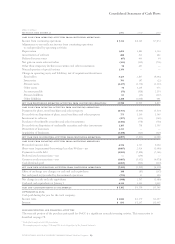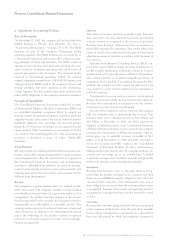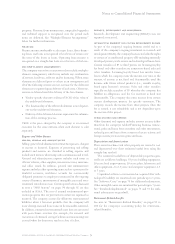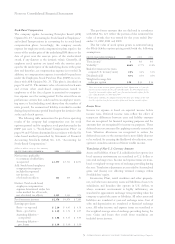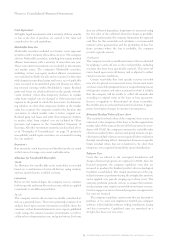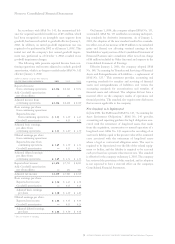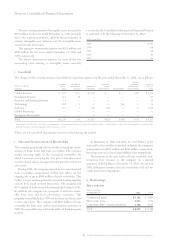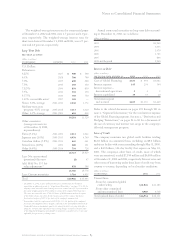IBM 2002 Annual Report Download - page 76
Download and view the complete annual report
Please find page 76 of the 2002 IBM annual report below. You can navigate through the pages in the report by either clicking on the pages listed below, or by using the keyword search tool below to find specific information within the annual report.
Notes to Consolidated Financial Statements
74 international business machines corporation and Subsidiary Companies
Cash Equivalents
All highly liquid investments with a maturity of three months
or less at the date of purchase are carried at fair value and
considered to be cash equivalents.
Marketable Securities
Marketable securities included in Current assets represent
securities with a maturity of less than one year. The company
also has Marketable securities, including non-equity method
alliance investments, with a maturity of more than one year.
These non-current investments are included in Investments
and sundry assets. The company’s Marketable securities,
including certain non-equity method alliance investments,
are considered available for sale and are reported at fair value
with changes in unrealized gains and losses, net of applicable
taxes, recorded in Accumulated gains and (losses) not affect-
ing retained earnings within Stockholders’ equity. Realized
gains and losses are calculated based on the specific identifi-
cation method. Other-than-temporary declines in market
value from original cost are charged to Other (income) and
expense in the period in which the loss occurs. In determin-
ing whether an other-than-temporary decline in the market
value has occurred, the company considers the duration that
and extent to which market value is below original cost.
Realized gains and losses and other than temporary declines
in market value from original cost are included in Other
(income) and expense in the Consolidated Statement of
Earnings. All other investment securities not described above
or in “Principles of Consolidation” on page 70, primarily
non-publicly traded equity securities, are accounted for using
the cost method.
Inventories
Raw materials, work in process and finished goods are stated
at the lower of average cost or net realizable value.
Allowance for Uncollectible Receivables
trade
An allowance for uncollectible trade receivables is recorded
based on a combination of write-off history, aging analysis,
and any specific known troubled accounts.
financing
Below are the methodologies the company uses to calculate
both its specific and its unallocated reserves, which are applied
consistently to its different portfolios.
Specific
The company reviews all accounts receivable considered at
risk on a quarterly basis. The review primarily consists of an
analysis based upon current information available about the
customer, such as financial statements, news reports, published
credit ratings, the current economic environment, as well as,
collateral net of repossession cost, and prior history. For loans
that are collateral dependent, impairment is measured using
the fair value of the collateral when foreclosure is probable.
Using this information, the company determines the expected
cash flow for the receivable and calculates a recommended
estimate of the potential loss and the probability of loss. For
those accounts where the loss is probable, the company
records a specific reserve.
Unallocated
The company records an unallocated reserve that is calculated
by applying a write-off rate to the total portfolio, excluding
accounts that have been specifically reserved. This write-off
rate is based upon write-off history and is adjusted to reflect
current economic conditions.
Certain receivables that have specific reserves recorded
may also be placed on nonaccrual status. Nonaccrual assets
are those receivables (impaired loans or nonperforming leases)
with specific reserves and other accounts for which it is likely
that the company will be unable to collect all amounts due
according to original terms of the lease or loan agreement.
Income recognition is discontinued on these receivables.
Receivables may be removed from nonaccrual status, if appro-
priate, based upon changes in customer circumstances.
Estimated Residual Values of Lease Assets
The recorded residual values of the company’s lease assets are
estimated at the inception of the lease to be the expected fair
market value of the assets at the end of the lease term. In accor-
dance with GAAP, the company reassesses the realizable value
of its lease residual values, and any anticipated increases in spe-
cific future residual values are not recognized before realization
through remarketing efforts. Anticipated decreases in specific
future residual values that are considered to be other than
temporary are recognized immediately upon identification.
Software Costs
Costs that are related to the conceptual formulation and
design of licensed programs are expensed as R&D. Also, for
licensed programs, the company capitalizes costs that are
incurred to produce the finished product after technological
feasibility is established. The annual amortization of the cap-
italized amounts is performed using the straight-line method,
and is applied over periods ranging up to three years. The
company performs periodic reviews to ensure that unamor-
tized program costs remain recoverable from future revenue.
Costs to support or service licensed programs are expensed as
the costs are incurred.
The company capitalizes certain costs that are incurred to
purchase or to create and implement internal-use computer
software, which includes software coding, installation, testing
and data conversion. Capitalized costs are amortized on a
straight-line basis over two years.


